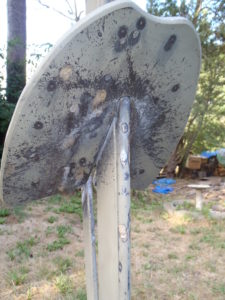Only shoot at my targets after you have read and understand the warnings and instructions that are on this page.
Warnings and other things to think about!

Follow all precautions when it comes to safely shooting steel targets. Splashback and deflections are always a possibility when shooting steel targets.
Eye protection, long sleeves and pants must be worn when shooting steel.
Acceptable Ammunition
Use only lead, plated, FMJ, Hollowpoints or Frangible rounds. Do not use any type of solid copper, steel core or armor piercing rounds on the target as they will damage the strike plates.
Do not use any rounds rated at faster than 3000 feet per second.
Do not use so called “green” rounds as the way they are made will damage the target.
Use only lead shot shotgun rounds, no hevi shot, steel or tungsten. No slugs yet as I have not done enough testing with them.
Acceptable Weapon Calibers
Use only approved Calibers. All common defensive pistols made are acceptable. Do not use any pistol chambered for an unapproved rifle caliber. Pistol rounds from Sub guns are OK as well.
Currently the RPS model of the target can be hit with .223/5.56, 300 Blackout (subs and supersonic), 7.62×39 and 6.8SPC as well as 7.62x40WT. More calibers will be added as testing is done.
Deflections
This target does not destroy projectiles, instead it deflects them to the ground. Seeing large chunks fly to the ground is common and not to be unexpected.
Target should only be used on a range surface made of dirt, sand or gravel. Do not use it on unprotected concrete, asphalt or other type of hard surface.
You can use it on concrete or other hard surfaces if some sort of protective material is in place to absorb deflections. The chopped up rubber used for backstops for indoor ranges is acceptable.
The angled strike plates create an impact zone about 4 feet behind the center pillar that should be kept clear of any object that can cause an unwanted deflection.
Engaging the Target at an Angle
The head and chest strike plates can be engaged from off center. You can move 30 degrees to either side and the target will still function as designed but be cautious of deflections that are now going in a new direction.
Hip plates should only be engaged while centered on the target. And no closer than 7 yards with pistol, 10 or more yards with rifle. These restrictions are mainly from how the armor protects all the linkage and the main pivot.
